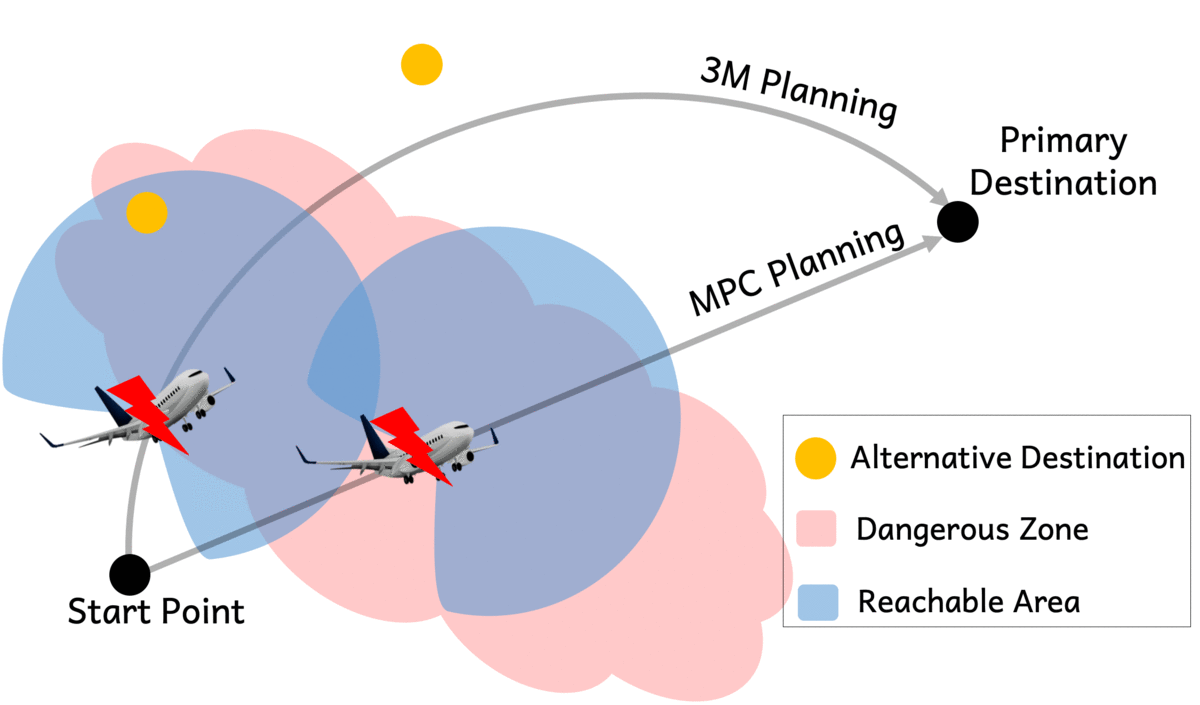Safe Planning under Large Uncertainties
Background & Motivation:
Miracle on the Hudson: On January 15, 2009, U.S. Airways Flight 1549, an Airbus A320 left LaGuardia Airport in New York City en route to Seattle. Shortly after takeoff, the plane struck a flock of birds and lost two engines. Faced with few options, the captain, Chesley Sullenberger (“Sully”), made the correct decision by landing the plane on the Hudson River instead of attempting to reach any airport for an emergency landing. According to the air traffic control audio, Sully first tried to turn back towards LaGuardia when he realized that both engines were lost. After few seconds, he decided to abort the mission to LaGuardia and select Teterboro Airport for landing. On the way approaching Teterboro, he made a conclusion that Teterboro was not feasible and finally decided to ditch in the Hudson River, saving all the lives of the 155 people on board.
Fig. 1: US Airways Flight 1549 after crashing into the Hudson River ([Wikipedia](https://en.wikipedia.org/wiki/US_Airways_Flight_1549))
Sully is a fighter pilot and training officer with the United States Air Force and has 30 years of experience in operating commercial airlines, which no doubt was one of the factors in his quick and correct decision making. He is a well-trained and experienced pilot who has the capability to determine several new feasible missions when the current mission is aborted and mentally plan the new flight paths.
Objectives:
However, not all passengers are lucky enough to have him with such capability guiding their flights. Inspired by the Miracle on the Hudson, we aim to design a decision-making architecture, mimicking what captain Sullenberger was planning, that can quickly make a sequence of decisions towards obtaining optimal safety in autonomous systems under large uncertainties.
Fig. 2: Decision Making Architecture
Machine-level Decision Making
- Backup-plan Constrained Path Planning: We proposed a multi-horizon and multi-destination model predictive control framework (3M) for the backup-plan constrained path planning. The existing development of multi-objective MPC could provide a basis for multi-destination path planning problems to realize backup-plan safety. However, due to the singularity of the control horizon, the cost functions for alternative destinations are not well evaluated, resulting in the absence of the state trajectories and corresponding control inputs with respect to the alternative destinations. In other words, there are no full trajectories generated toward alternative destinations, i.e., there are no backup-plan paths. We synthesized 3M and with the sampling-based scheme from model predictive path integral control with \(\mathcal{L}_1\) augmentation to guarantee finite computation time and robustness.
- Model Learning and Estimation: (Under Development…)
Human-level Decision Making
- (Under Development…)
Presentations:
Publications:
- Kim, H., Yoon, HJ., Wan, W., Hovakimyan, N., Voulgaris, P. G., and Sha, L.. (2021) Backup Plan Constrained Model Predictive Control. In IEEE 60th Conference on Decision and Control (CDC). (Accepted)
